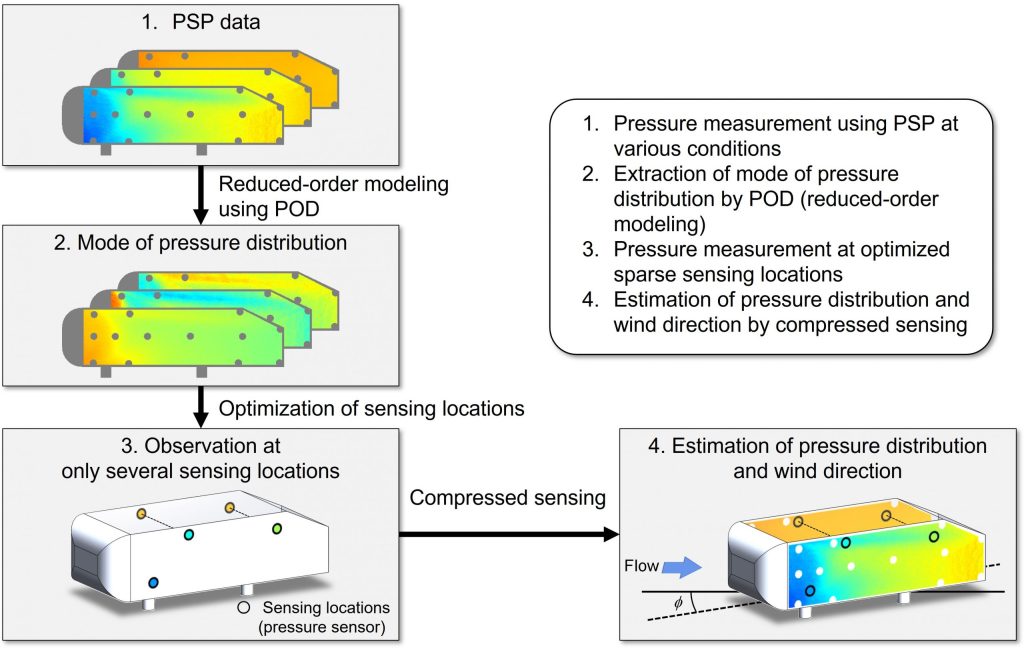About Advanced Measurement Group
Surface pressure, frictional stress, and temperature are essential quantities of state for the design of aircraft, railways, automobiles, and other vehicles. By measuring these state quantities, we can understand fluid phenomena such as boundary layer transitions, vortex emissions, and shock waves. Our group is working on molecular imaging to visualize and measure the state quantity using functional molecular sensors. Also, we are working on super-resolution measurements to improve the temporal and spatial resolution of the measurements using data-driven science.
Super-Resolution Measurement
Experimental measurements have become more sophisticated, faster and with higher resolution every year. However, there are still some problems in the flow field, such as supersonic turbulence, which requires high speed and high-resolution measurements. Point sensors, such as unsteady pressure sensors, are capable of very fast sampling and high time resolution measurements, but even with multi-point measurements, fine structures, such as turbulence, are not fully resolved. On the other hand, measurements using high-speed cameras, such as PSP and PIV measurements, can measure in high spatial resolution, but the sampling speed is slower and the temporal resolution is lower than that of point sensors. Therefore, we are applying the techniques of data-driven science to realize high-spatiotemporal resolution measurements by combining measurements with low spatial resolution but high temporal resolution and measurements with high resolution but low temporal resolution.
1. Three-Dimensional Density Field Reconstruction of Supersonic Jet using BOS Method
The supersonic exhaust jets of rocket engines or jet engines of supersonic airplane generates strong acoustic wave. The generation of the acoustic wave is related to unsteady fluid phenomena such as turbulent-shock wave interaction and generation of large scale turbulent structure in the shear layer. In this research, in order to clarify the fluid phenomena of supersonic jets in detail, we visualize the three-dimensional fluid phenomena using the three-Dimensional Background Oriented Schlieren (3D-BOS) method. Currently, we are applying data-driven science techniques to the 3D-BOS method to reconstruct the 3D density field with high temporal and spatial resolutions.
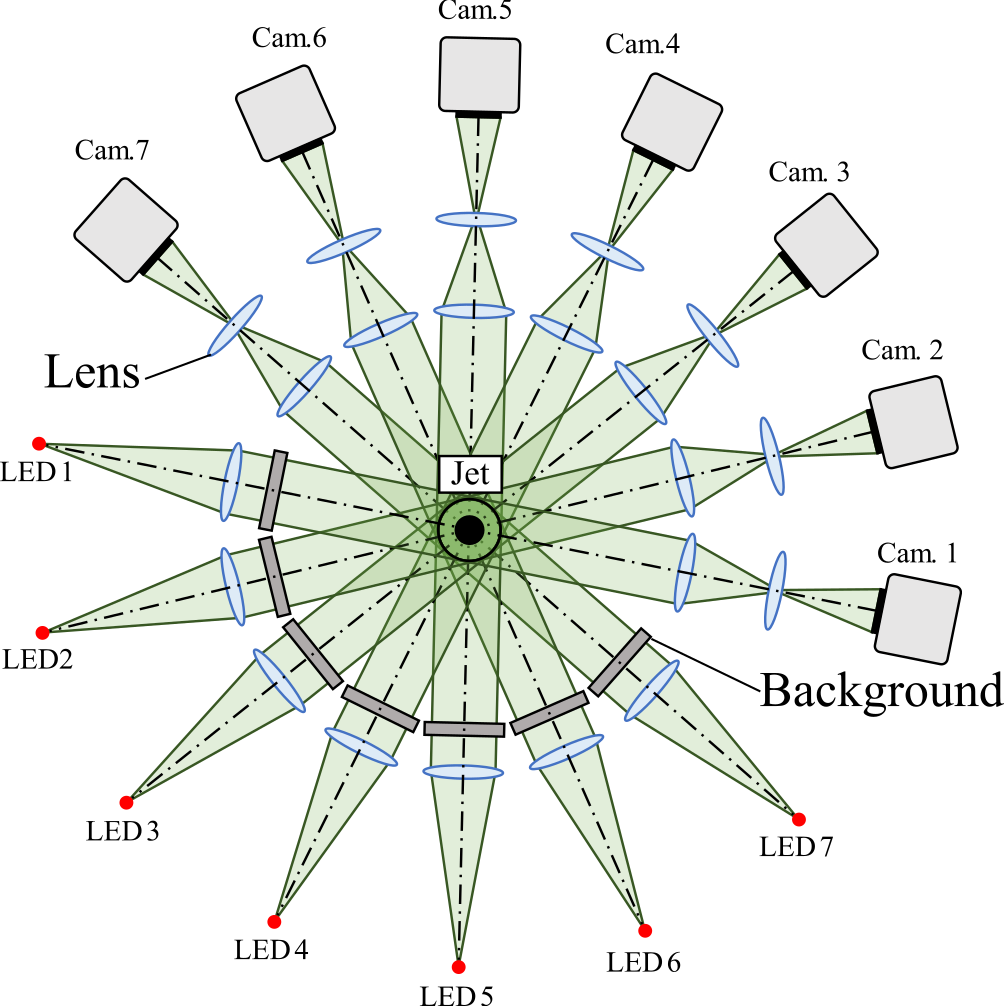
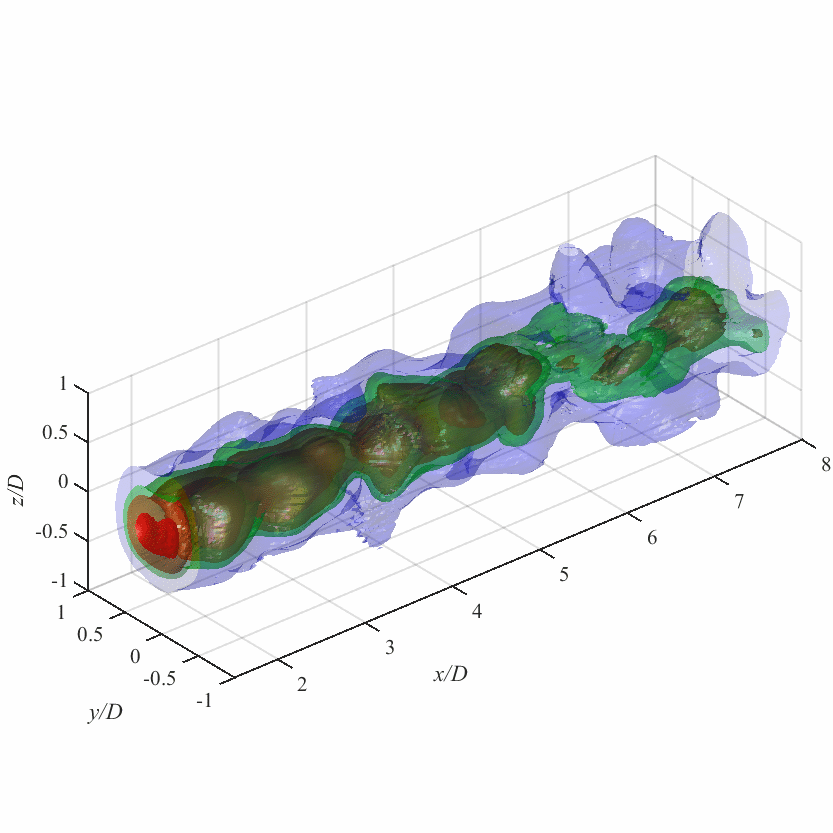
2. Time Super-resolution Measurement of Velocity Fields using Time-resolved Acoustic Measurements and Non-time-resolved PIV Measurements
High-speed cameras, which can continuously photograph ultra-high-speed physical phenomena in high definition, are one of the most powerful devices for elucidating physics. However, even with the latest high-speed cameras, the shooting speed is still insufficient, and further speeding up is desired. In this research, we applied signal processing called compressed sensing, which restores the original information from a small amount of observation data, to two different simultaneous measurement data of image measurement and acoustic measurement, thereby improving the imaging speed and the measurement points. This technology combines images taken by a point sensor with high temporal resolution but low spatial resolution and a high-speed camera with high spatial resolution but low temporal resolution using a low-dimensional model to reconstruct measurement data that have both temporal and spatial resolution. We applied this to velocity field measurements and acoustic measurements of the supersonic jet and succeeded in reconstructing velocity field fluctuations, which were previously difficult to measure, as continuous images at 50 times the imaging speed.
This technology is versatile, and by combining various visualization methods and point sensors, it can be expected to dramatically advance the understanding of ultra-high-speed and complex phenomena in a variety of fields, not just fluid mechanics.
3. Time Super-resolution Measurement of Three-dimensional Velocity Fields using Time-resolved Acoustic Measurements and Non-time-resolved PIV Measurements
Three-dimensional unsteady fluid field measurements require multiple high-speed cameras with high temporal and spatial resolution. In particular, three-dimensional measurement of extremely fast flows such as supersonic speeds not only poses technical issues with the measurement equipment mentioned above, but also poses cost issues. To solve this problem, we extended the above method by taking into account the characteristics of the jet's circumferential mode. This makes it possible to reconstruct the time-resolved three-dimensional flow velocity fluctuation velocity field of a supersonic jet, which has not been possible until now through measurements.
Molecular Imaging
We are developing technologies to measure state quantities by applying functional molecular sensors that emit fluorescence and phosphorescence, such as pressure-sensitive and temperature-sensitive paint (PSP / TSP) measurement and luminescent oil film (GLOF) method. In recent years, we have been conducting research to realize highly accurate and high spatiotemporal resolution measurements in various velocity regions, targeting "unsteady fluid phenomena". In the following, the research contents of PSP and GLOF are introduced.
1. Development of Fast-Responding PSP with Low Surface Roughness
Since a large surface roughness of conventional fast-response PSP, it could not be used for industrial wind tunnel tests and comparison with numerical simulation. Our group has developed the fast-responding PSP with low surface roughness by developing and using the equipment to support PSP development such as an automatic calibration device and laser microscope. In addition to academic research, further improvements are being made to the low surface roughness fast-responding PSP for application to industrial product development. Furthermore, we are developing the AA-PSP toward the measurement of speed fluid phenomena exceeding 10 kHz.
2. Unsteady PSP Measurement in Low-Speed Wind Tunnel Tests
In the low-speed wind tunnel test, the pressure fluctuation is several Pa to several hundred Pa, and the signal-to-noise ratio is not sufficient for the conventional unsteady PSP measurement. We have developed a PSP with sufficient emission intensity change for small-amplitude pressure fluctuations and improved the signal-to-noise ratio by post-processing methods, and succeeded in quantitative measurements of pressure fluctuations caused by Kármán vortex vortices released from a square cylinder in a low-speed flow. Currently, we are developing techniques to measure even higher frequencies and smaller amplitudes of phenomena such as aerodynamic acoustics. We are also applying and developing data-driven noise reduction methods such as singular value decomposition and Kalman filters to expand the application of PSP measurement in terms of both measurement and post-processing.
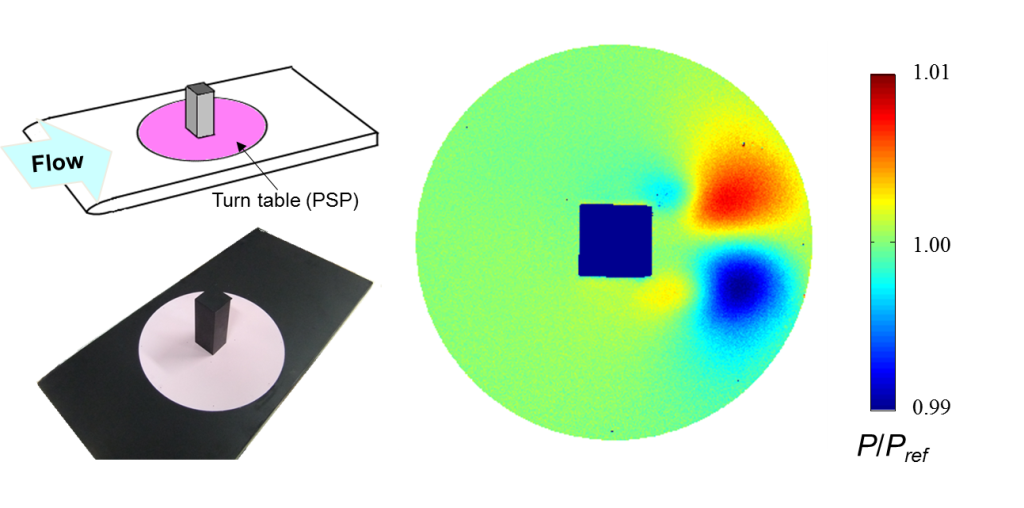
3. Time-Resolved Pressure Distribution Measurement on Wing Surface of Commerical Airplane using Fast-Responding PSP with Low Surface Roughness (joint research with JAXA)
When an aircraft flies at transonic speed (near the speed of sound), a shock wave is generated on the wings. This shock wave not only increases the drag on the aircraft, but also causes a phenomenon called "transonic buffet", which causes harmful vibrations to the aircraft depending on the flight conditions. In this laboratory, we measured the pressure distribution on the wing surface of a commercial aircraft model using the fast-responding PSP with low surface roughness, which was newly developed in our group in collaboration with JAXA. Our group succeeded in the quantitative measurement of the unsteady pressure distribution in transonic buffeting cases. Based on this data, we are now investigating the buffeting phenomenon of three-dimensional transonic velocity on the wing.
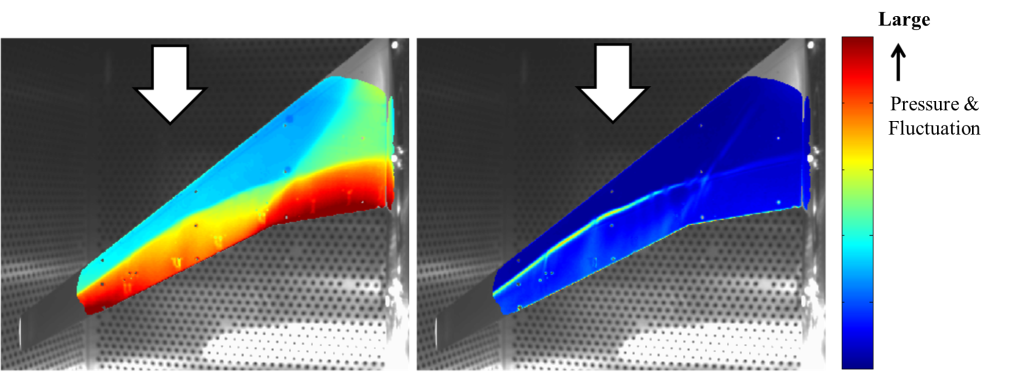
4. Visualization and Measurement of Skin Friction Field using GLOF Method
In order to measure and understand the frictional drag force that acts on an aircraft during cruising and the phenomena such as boundary layer transition and separation/reattachment, it is important to know the distribution of frictional stress on the surface of an object and its structure (topology). However, the conventional measurement method is point measurement, and it was difficult to measure the distribution. Recently, a global shear stress measurement method using the global luminescent oil film visualization (GLOF) has been developed. This method calculates the shear stress vector field by analyzing the time-resolved heat flux field obtained by the TSP measurement or by analyzing the visualization of the flow near the wall by the GLOF. It is expected to be applied to surface measurement of wall friction stress field. Our laboratory aims to establish a highly reliable method for measuring frictional stress fields by developing a new GLOF analysis method. Furthermore, we are applying the developed image analysis method to various flow fields to clarify the phenomenon. The source code is available here.

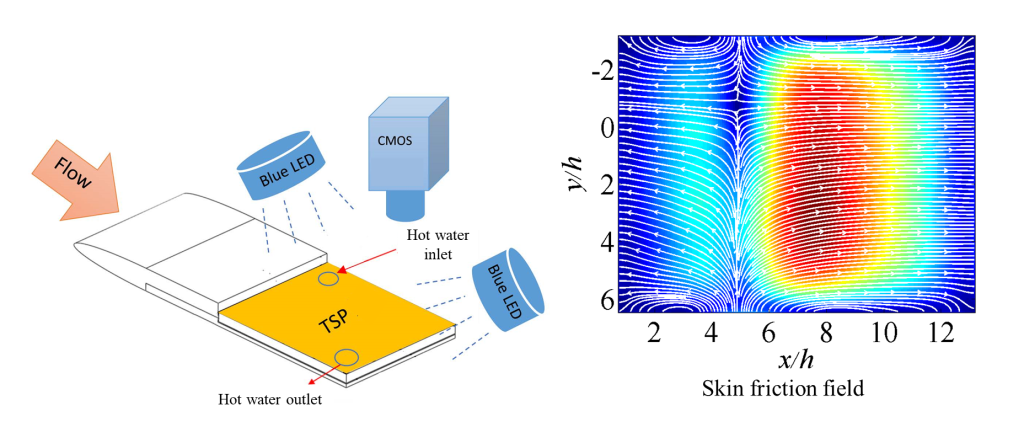
5, Integration with Data-driven Reduced-order Model
Pressure-sensitive paints are highly compatible with sparse sensing because surface measurement is possible. In the example shown below, the surface pressure field on the vehicle is acquired, a reduced-order model of the pressure distribution is constructed, and the appropriate sensing location is selected in advance. Then, during actual operation, they are used to estimate the pressure distribution on the vehicle surface and the wind direction around the vehicle body with high accuracy from information obtained by several semiconductor pressure sensors. This is a new method that is completely different from the conventional method implementing a large number of sensors in the car body and has the potential to be easily implemented in commercially available cars. This technology instantly estimates the wind pressure distribution on the surface of a moving vehicle and the direction of the surrounding wind, improving the stability of self-driving vehicles against gusts of wind and reducing air drag for convoys of trucks traveling in platoons.
